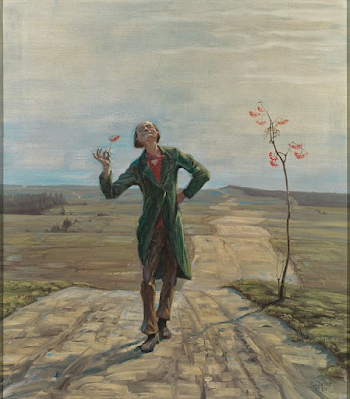A memorial monument in the Jewish cemetery in Berlin's Weissensee neighborhood to members of the Herbert Baum Group,
Saturday, 4 March 2023
The Baum Group – Resisting Nazis in Berlin
A memorial monument in the Jewish cemetery in Berlin's Weissensee neighborhood to members of the Herbert Baum Group,
Thursday, 2 March 2023
Remembering Catalan Anarchist Militant Salvador Puig Antich, the Last Political Prisoner to be executed in Franco's Spain by the Garrotte.
On the morning of 2 March 1974, the young Catalan anarchist militant Salvador Puig Antich, became the last political prisoner to be executed in Franco's Spain by the garrotte which saw the state literally strangling him to death after twenty minutes of agony in the courtyard of Modelo Prison, Barcelona.
Wednesday, 1 March 2023
In Celebration of St David's Day/ Dydd Gŵyl Dewi
It's become a bit of a tradition to mark the very special occasion of St David's Day/ Dydd Gŵyl Dewi, which celebrates my nations patron saint.Today we, as a country. come together to celebrate our culture. history and everything that makes us proud to be Welsh.
Geriau/ Words
Pethau bychain Dewi Sant
nid swn tan ond swn tant.
Nid derw mawr ond adar mân,
nid haul a lleuad ond gwreichion tân.
Ond o, dyna chi strach, trio cael hyd i sach
i gadw'r holl bethau bach.
Pethau bychain Dewi Sant,
y ll'godan ond nid yr eliffant.
A darnau'r gwlith nid dwr y moroedd,
ond yn y briga', stwr y mae.
Ond o, dyna chi strach, trio cael hyd i sach
i gadw'r holl bethau bach.
Pethau bychain Dewi Sant,
swn 'yn traed ni yn y nant.
Yr hada' yn disgyn yma a thraw,
a'r tamad, y tamad ola' o wenith yn dy law.
Ond o, dyna chi strach,
trio cael hyd i sach
i gadw'r holl bethau bach.
Map y byd yn llyfr y plant,
pethau bychain Dewi Sant.
Y pellter sydd rhwng dant a dant ar ol nawdeg naw a chant
pethau bychain Dewi Sant.
Ond o, dyna chi strach,
trio cael hyd i sach
i gadw'r holl bethau bach.
English Translation Lyrics:
St David's little things,
not the sound of fire
but the sound of chords.
Not a large oak but small birds,
not the sun and moon but the sparks of fire.
But oh, what a hassle it is to try and find a sack
to keep all of the little things.
St David's little things,
the mouse but not the eliphant.
And the dew drops, not the water of the seas,
but in the branches, uproar is found
But oh, what a hassle it is to try and find
a sack
to keep all of the little things.
St David's little things,
the sound of our footsteps in the stream.
The seeds fall here and there,
and the scrap, the last scrap of wheat in your palm.
But oh, what a hassle it is to try and find a sack
to keep all of the little things.
The world's atlas in a children's book,
St David's little things.
The distance between a tooth and a tooth between ninety nine and a hundred - St David's little things.
But oh, what a hassle it is to try and find
a sack
to keep all of the little things.
War (Rhyfel) by Hedd Wyn
English translation by Gillian Clarke
Bitter to live in times like these.
While God declines beyond the seas;
Instead, man, king or peasantry,
Raises his gross authority.
When he thinks God has gone away
Man takes up his sword to slay
His brother; we can hear death’s roar.
It shadows the hovels of the poor.
Like the old songs they left behind,
We hung our harps in the willows again.
Ballads of boys blow on the wind,
Their blood is mingled with the rain.
Original Welsh poem by Hedd Wyn
Gwae fi fy myw mewn oes mor ddreng,
A Duw ar drai ar orwel pell;
O’i ôl mae dyn, yn deyrn a gwreng,
Yn codi ei awdurdod hell.
Pan deimlodd fyned ymaith Dduw
Cyfododd gledd i ladd ei frawd;
Mae sŵn yr ymladd ar ein clyw,
A’i gysgod ar fythynnod tlawd.
Mae’r hen delynau genid gynt,
Ynghrog ar gangau’r helyg draw,
A gwaedd y bechgyn lond y gwynt,
A’u gwaed yn gymysg efo’r glaw.
Links to a few earlier St David's Day/ Dydd Gŵyl Dewi Posts
Gillian Clarke - Miracle on St David's David's Day
https://teifidancer-teifidancer.blogspot.com/2013/03/gillian-clarke-8637-miracle-on-st.html
The Praise of St David's Day Showing the reason why the Welch -men Honour the Leeke on this Day
https://teifidancer-teifidancer.blogspot.com/2016/03/the-praise-of-st-davids-day-showing.html
Evan James (Ieuan ap Iago) An Ivorite song to be sung to the tune of Hen Wlad Fy Nhadau
https://teifidancer-teifidancer.blogspot.com/2014/03/evan-james-ieuan-ap-iago-1809-2091878.html
Harri Webb - The Red , White and Green
https://teifidancer-teifidancer.blogspot.com/2017/03/harri-webb-7920-311294-red-white-and.html
The Welsh Language - Alan Llwyd
https://teifidancer-teifidancer.blogspot.com/2015/03/the-welsh-language-alan-llwyd-b1948.html
Monday, 27 February 2023
Remembering occupation of Wounded Knee and continuing injustice of Leonard Peltier
He was never given a fair trial, faced with an all white jury,federal authorities quashed or destroyed thousands of pages of evidence which would have led to his freedom.The ballistic evidence was deeply flawed, and no real links to identify Mr Peltier with the murder.
.He has continued to be a victim of the racism and corruption embedded in the US criminal justice system. But Leonard Peltier is not simply a victim, he is also a fighter, writer, activist, grandfather, Nobel Peace Prize nominee, and was the Presidential candidate for the Peace and Freedom Party in 2004 whose spirit refuses to be beaten. Leonard his friends family and comrades have fought over the years for real justice to be done. In the years since his conviction, millions upon millions of people around the world have come to learn of his case, agree that he is innocent and demand his freedom. His most recent petition for release on parole was denied in 2009, and I understand that he is not eligible for consideration for parole again until 2024.
Leonard Peltier
Monday, 20 February 2023
One who goes his own way
Poem loosely inspired by painting above which is called 'One who goes his own way' by German artist Hans Dieter 1861- 1968
Friday, 17 February 2023
Remembering the life of Revolutionary Black Panther Huey P Newton (February 17, 1942 – August 22, 1989)
Huey Percy Newton was an American revolutionary and political activist who was born on February 17, 1942 in Monroe, Louisiana the youngest of Walter Newton and Armelia Johnson’s seven children. Walter Newton was a Baptist preacher, sharecropper, and, at one time or another, worker in the local sawmills and sugarcane mills. He co-founded the Black Panther Party, a Marxist-Leninist political organisation, that played a pivotal role in the 1960'-70's in defending Black communities against discrimination and the harsh economic and social conditions these communities faced in the US.
what u set out 2 do
instead they chose 2
ridicule u
when u got weak
they loved the sight
of your dimming
and flickering starlight
How could they understand what was so intricate
2 be loved by so many, so intimate
they wanted 2 c your lifeless corpse
this way u could not alter the course
of ignorance that they have set
2 make my people forget
what they have done
for much 2 long 2 just forget and carry on
I had loved u forever because of who u r
and now I mourn our fallen star.
Thursday, 16 February 2023
Keep Dancing Without Chains
( For Dimlo)
Last weekend we celebrated a brother
Forgot differences of opinion,
As we swayed in dance rhythm
To dub techno psychedelic vibration
Acoustic magical notation
Trance drumming of deep devotion
On dancefloor all equal
In ocean of glorious sound
Leaving behind inhibition
There is something amazing about this
The resonance off holy music
That continues to keep spinning
Allows us to carry on smiling
Love that will always sustain us
Take us to another dimension
On a trail of time and truth
Ecstatic healing inclination
Of deep stimulating elevation.
Tuesday, 14 February 2023
Love Conquers Hate
Valentine's Day is a time to celebrate romance and love But the origins of this festival are actually rather dark. From Feb. 13 to 15, the Romans celebrated the feast of Lupercalia. The men sacrificed a goat and a dog, then whipped women with the hides of the animals they had just slain.Young women would actually line up for the men to hit them.. They believed this would make them fertile.
Friday, 10 February 2023
'30p Lee' Anderson becomes Tory deputy chairman
'30p Lee'' Anderson, the 56 year old ex miner and Tory MP for Ashfield has become the Deputy Chairman of the party, five years after defecting from Labour who he represented as a councillor before he went on to serve as a Tory councillor in Mansfield and just over three years after his election to the seat. despite being known for a number of unsavoury things he has said and done..

.jpg)















